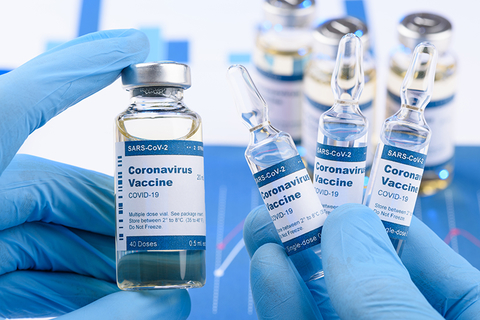
With a slate of COVID-19 vaccine candidates poised to cross regulators’ desks in December, academic institutions and drugmakers are already eyeing second-generation shots to build on those advanced in the pandemic’s first year. Iowa State University is spearheading one such effort, securing a trio of partners, plus a $2 million grant, to help drive early development work on its vaccine 2.0.
[huge_it_slider id=”15″]The Nanovaccine Institute at Iowa State University says it’s developing a next-generation nanovaccine against SARS-CoV-2, the virus that causes COVID-19, and it recently tapped drug delivery specialist Zeteo Biomedical to lend its device and technical support, the partners announced separately.
Nanovaccines like Iowa State’s work by loading viral proteins into nanoparticles, about 300 billionths of a meter across, made from biodegradable polymers, the institute said in a release. Crucially, Iowa State’s candidate will be formulated as a single-dose nasal spray, deliverable by way of a solitary sniff.
That alternative to traditional glass vials and syringes could be a boon for the needle-averse and save on highly sought-after supplies; plus, it paves for the way for patients or caregivers to potentially self-administer the vaccine, easing the burden on healthcare workers and cutting the risk of viral spread in one fell swoop—if the candidate wins out in the clinic, that is.
Zeteo will also provide technical services to help evaluate Iowa State’s room-temp stable vaccine, the company said in a release. Alongside more convenient dosing, the Nanovaccine Institute aims to cut out the need for refrigeration of its candidate—potentially lending the vaccine a storage edge over competitors.
As Pfizer and Moderna’s mRNA candidates approach the finish line, concern has mounted over the shots’ frigid cold chain requirements and the supply and distribution hiccups that could ensue. Pfizer’s vaccine, for instance, must be kept at minus 94 degrees Fahrenheit (minus 70 degrees Celsius) and will only last for around 24 hours at refrigerated temps between 35.6 F and 46.4 F.
Moderna’s is set to fare slightly better, boasting stability for up to 30 days at refrigerated temperatures and up to 12 hours at room temp, though it still must be stored at minus 4 F—a temperature more familiar to distributors—for longer-term storage and shipping.
Should Iowa State’s vaccine win out in the clinic and break into the mainstream, Zeteo’s delivery platform is commercially scalable to the fill-finish stage and could potentially deliver millions of doses of intranasal drugs or vaccines per day, the company said.
Alongside Zeteo, Iowa State has enlisted two other partners in the form of Ames, Iowa-based wireless sensor startup Skroot Laboratory and Southwest Research Institute, a manufacturing-support nonprofit out of San Antonio.
Meanwhile, the project will share equipment and expertise with vaccine developers with operations in Iowa, the Nanovaccine Institute said.
Back in late October, the university bagged $2 million in funding from the federal Coronavirus Aid, Relief and Economic Security (CARES) Act, delivered through the state of Iowa, for its vaccine work. The project has been fast-tracked, building on previous research and existing patents by Iowa State University and University of Iowa researchers associated with the Nanovaccine Institute. The project is expected to be “largely completed” by year-end, the institute said.
The work is still early-stage stuff, with more development time needed before the researchers can even move into animal testing, but the Nanovaccine Institute is confident its second-generation vaccine will fill an urgent, unmet need once a number of early shots hit the market.
“Our approach will result in the development and pre-clinical testing of a novel SARS-CoV-2 nannovaccine that will overcome current shortcomings and be ready for clinical trials with multiple partners,” the researchers wrote.
Iowa State isn’t the only one looking into new-and-improved formulations of COVID-19 drugs and vaccines, either. Pfizer, well aware of the cold chain hurdles its shot must overcome, is already weighing a powder formulation, unburdened by ultra-cold storage requirements, that could roll out in 2021, Mikael Dolsten, M.D., Ph.D., chief scientific officer at the company, told Business Insider earlier this month.
Just last week, Uğur Şahin, CEO of German mRNA specialist BioNTech, which developed Pfizer’s shot, confirmed in a CNN interview that his company was working on a novel formulation of its candidate, shippable at room temperature, that could launch by the second half of next year.
And in the U.K., Vaccitech—developer of ChAdOx1, the chimpanzee adenovirus vector behind AstraZeneca and the University of Oxford’s shot—recently scored a grant of up to £2.3 million ($3.0 million) to advance its own next-gen candidate that it thinks could serve as a standalone product or improve on first-generation prophylactics. Vaccitech is currently wrapping up preclinical development and locking down clinical supply for a phase 1 trial pegged to start next year.
We use cookies to improve your experience on our site. By using our site, you consent to cookies.
Manage your cookie preferences below:
Essential cookies enable basic functions and are necessary for the proper function of the website.
These cookies are needed for adding comments on this website.
Statistics cookies collect information anonymously. This information helps us understand how visitors use our website.
Google Analytics is a powerful tool that tracks and analyzes website traffic for informed marketing decisions.
Service URL: policies.google.com (opens in a new window)
Marketing cookies are used to follow visitors to websites. The intention is to show ads that are relevant and engaging to the individual user.
You can find more information in our Cookie Policy and Privacy Policy.